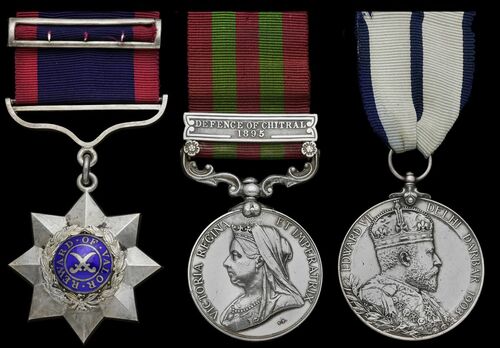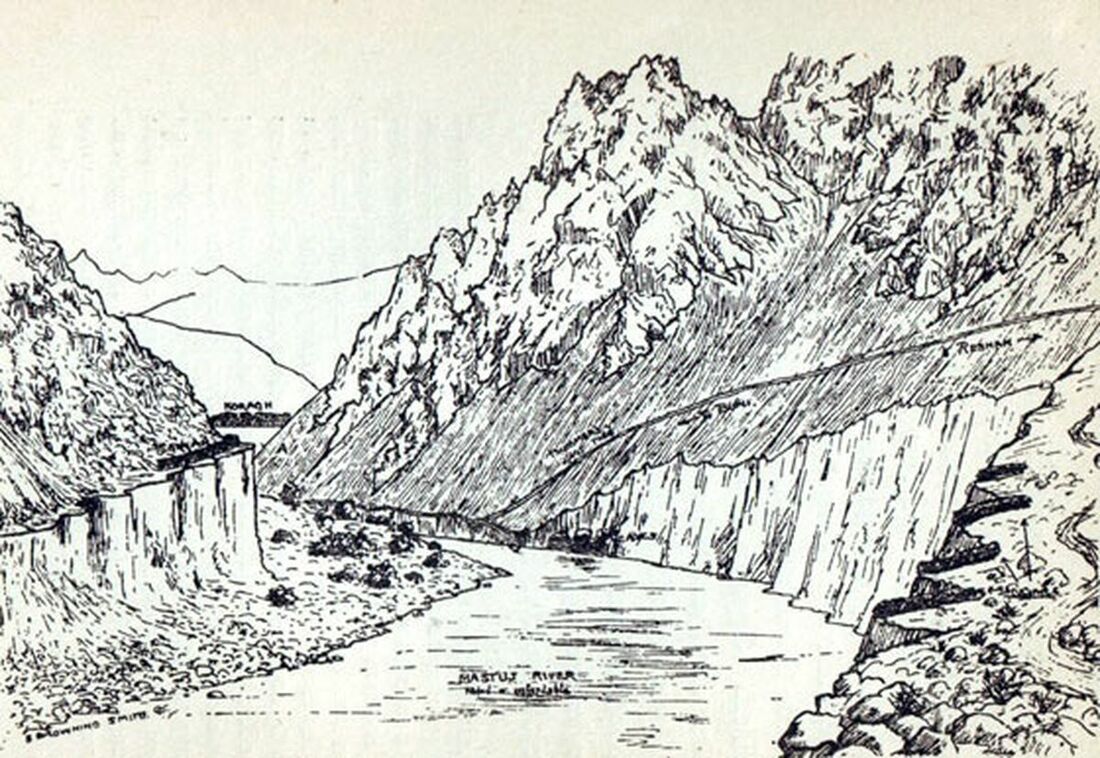Auction: 23001 - Orders, Decorations and Medals
Lot: 213
A superb Chitral Indian Order of Merit group of three awarded to Havildar Soddah Sing, 14th Sikhs, for gallantry at the Koragh Defile, a disaster from which only 15 men emerged alive
Indian Order of Merit, 3rd class, the reverse officially engraved '3rd Class Order of Merit' with silver ribbon buckle; India General Service 1895-1902, 1 clasp, Defence of Chitral 1895 (1629 Naick Soddah Singh. 14th Bl. Infy.); Delhi Durbar 1903, unnamed as issued, good very fine (3)
Provenance:
DNW, June 2002.
l.O.M. G.G.O. 742 of 1895:
'The undermentioned non-commissioned officers and men of the 14th (Ferozepore Sikh) Regt. of Bengal Infantry, were granted the 3rd class, in recognition of the gallantry and devotion exhibited by them in the action at Koragh, in Chitral, on the 10th March 1895'.
There follows the names of 14 N.C.O's and men, including Naick Soddah Sing who was wounded by a gun shot in the abdomen. The story of this gallant party at the Koragh defile is the most remarkable incident of the entire Chitral affair, more so even than that of the defence of the fort at Chitral itself, or of Kelly’s heroic march to its relief.
Captain C. R. Ross, with Lieutenant H. J. Jones and a party of some 60 Sikhs, all of the 14th Bengal Infantry, who left Mastuj on 7 March to give assistance to Lieutenant Edwards at Reshun, became entrapped at Koragh on 8 March 1895. On reaching the Koragh defile, half a mile further on from the hamlet itself, the Sepoys noted with suspicion some empty sangars close to the track, also several men scattered over the hillside, but their commander remained optimistic. The defile is the result of the river cutting its winding course through terrible cliffs. At the lower end of this frightful gorge the pathway begins to ascend from the river above some caves and then zig-zags upwards. There the 'point' of the advanced guard was fired upon, and hundreds of men disclosed themselves.
Obviously the soldiers were in a trap. Everything depended on their getting out again, at whatever cost, before the exits were closed. The opposing force consisted entirely of Reshun villagers, poorly armed but incalculably favoured by their position. Nevertheless, many Chitralis are of the opinion that if Ross had pressed forward he might have got through to Lieutenant Edwards who was besieged at Reshun, though that is very doubtful, or if he had rushed back at once with all his men, he would certainly have got out. His losses in either case might have been heavy, but nothing like what they eventually became.
What he did was to order Jones back with ten men to seize the Koragh end of the defile; but what was formerly an empty sangar by the side of the road was now full of men, and before Jones reached the last shoot down which the rocks were tumbling, only two Sikhs remained with him. He sent back word of this to Ross, who thereupon withdrew his men into two caves beneath the path and close to the river, which at certain periods of the year submerges them. Jones joined them there. During the night they made another attempt to get out and seemed on the point of success when they were ordered back again. All the next day the caves were occupied. A large number of Chitralis fortified themselves on the opposite bank in a sangar, whence a continuous fire was maintained against the Sikhs, who erected breastworks for protection.
That night the poor fellows tried to escape by scaling the hillside but were brought up short by a precipice where a Sikh was lost. Thus they returned to the caves once more and passed another miserable day without food. Then Ross perceived he must cut his way out at all cost. Starting at two o'clock in the morning they rushed along, losing heavily. Ross behaved with astounding gallantry. It is related that he charged a sangar a little off the track by himself, and killed two or three of its inmates with his revolver at close quarters. Then a stone partially stunned him and he was shot dead.
Jones and seventeen Sepoys got through to the plain on the Koragh side of the defile, where two consecutive masses of charging swordsmen withered up and melted before them, teaching the Chitralis their bitter mistake in attacking Sikhs shoulder to shoulder on open ground. But three more were killed, and the remaining fourteen, ten of whom, including Jones, were grievously wounded, crawled painfully into Buni at six o'clock in the morning. These fourteen men and one other were the sole survivors of the sixty soldiers who entered the Koragh defile.
Lieutenant Jones was subsequently awarded the D.S.O. and each of the 14 surviving Sikhs received the Indian Order of Merit.
It should be noted that whereas the men of the 14th Sikhs who were besieged at Chitral fort earned the clasp ‘Defence of Chitral’, the men of the regiment who accompanied Captain Jones and were present at Koragh defile are technically entitled to the clasp ‘Relief of Chitral’. However, the medals of these gallant Koragh men almost invariably carry the clasp for ‘Defence of Chitral’, and it would seem likely that they were issued thus in error. Most collectors today understand that the Koragh men are many fewer than those who took part in the defence, and their medals are highly prized. Whilst there are no actual medal rolls in existence today, the Koragh men are easily identified - if they were not killed, they survived to win the Order of Merit. In either event their names are meticulously recorded.
Subject to 20% VAT on Buyer’s Premium. For more information please view Terms and Conditions for Buyers.
Sold for
£8,000
Starting price
£2800







